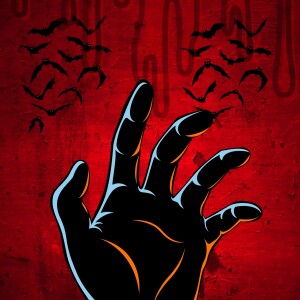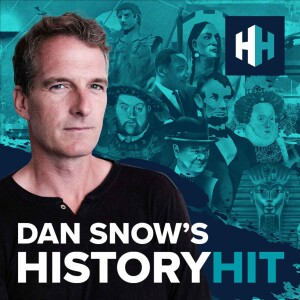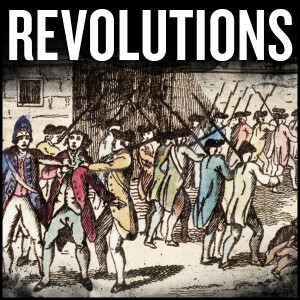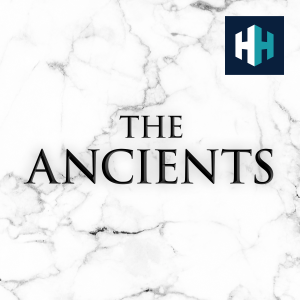

Read Beat (...and repeat)
https://feeds.buzzsprout.com/1950812.rssEpisode List

"Nightmare in the Pacific" by Michael Doyle
Michael Doyle's Nightmare in the Pacific is a book about an aspect of World War II you probably haven’t heard before: the saga of Artie Shaw, the big-band leader who took his group on a whirlwind tour of the Pacific in 1942-1943.What makes this story so interesting are the characters involved: Artie Shaw, himself, the motley group of band members that Shaw recruited himself, as well as figures from the worlds of the military and show business. Even before the United States joined the war, Shaw exhibited erratic behavior. At the top of his game in 1939, riding the success of big-band swing and a hit recording of Cole Porter’s “Begin the Beguine,” Shaw abruptly walked away from the bandstand, disappearing from sight to spend six weeks in Mexico without telling anyone of his whereabouts. That was a characteristic of Shaw’s, said Doyle. He would walk away from difficult situations throughout his life. Married eight times (among his brides: movie queens Lana Turner and Ava Gardner), Shaw often turned off the people who were closest to him.“He was probably a musical genius, but he was also prickly, short-tempered, and driven, Doyle noted. Shaw’s epic Pacific roadshow had him playing in Hawaii for several months before heading out to sea where Navy Band 501 played aboard ships, aircraft carriers, as well as indoor and outdoor venues in Guadalcanal, Australia, New Zealand, and islands in between. By all accounts, the band delivered regularly, sharing the hits of the day including his trademark tune "Nightmare," providing entertainment appreciated by military personnel who faced danger far from home.“Artie had traveled, by some accounting, 68,000 miles throughout the Pacific,” related Doyle in his book. “He had ducked into foxholes and hidden from bombs. He had felt his stomach lurch at sea and in the turbulent air. He had been bedside with the dying, and he had entertained admirals, generals, and foreign dignitaries. He had been cheered by thousands, and he had charmed the president’s wife,” he noted.And Shaw also had a nervous breakdown that ended his tenure as wartime bandleader. By 1944, Shaw was back in the States, trying to clear his head. The band, incidentally, kept playing under the guidance of Sam Donahue, a sax player with the band. The group was sent to play before military crowds in England. They soon became popular favorites, even beating the esteemed Glenn Miller Band in a battle-of-the-bands competition (before Miller lost his life when his airplane went down in the English Channel).As for Shaw, the post-war music scene brought change. It no longer made economic sense to take 20 musicians on the road. Following the trend that dictated smaller musical groups, Shaw formed the Gramercy Five. But in 1954 he decided to put away his clarinet and walk away from performing completely (save for a brief late-in-life resurrection). He took up sharpshooting as a hobby and appeared occasionally on the What’s My Line TV show.“As much of a jerk he could be, he had integrity,” said Doyle of Shaw, a musician who didn’t want to spend the last 50 years of his life playing “Begin the Beguine.”In his own 370-page autobiography, Shaw only devoted three pages to his wartime experiences. Doyle corrects that oversight.

"The Age of Choice" by Sophia Rosenfeld
A new book looks at the short history of the freedom of choice.Some of us have more choices than we’ve ever had—from what to buy and where to live and whom to love, even what to believe--but how did that come about? That’s the basis of the book Sophia Rosenfeld has written, called The Age of Choice: A History of Freedom in Modern Life.Rosenfeld said she wanted to find those times when the early forms of choice were taking shape—when you could marry whomever you wanted, shop for what you might need, and vote as you saw fit. “I tried to find the moments when the practice was new,” she said.We haven’t always had so many choices, said Rosenfeld, a professor of history at the University of Pennsylvania. The dance card is one example, as viewed by the author, of a measure of freedom that emerged in the 18th century, developed in the 19th century, and largely disappeared by the early 20th century. "Once, though, dance cards had a real function," Rosenfeld noted. Designed mostly by men and used mostly by women, the cards facilitated decision-making in the ballroom. A lady could show that her dance card was already full, but "the expectation for the woman was a yes," she said.The process was formal and may seem restrictive by today's standards, but it marked a step forward in the age of choice. “Rosenfeld demonstrates how modern societies have made the ability to choose the hallmark of freedom, whether in the marketplace, in ideas and belief systems, in courtship, in voting, in feminist and other rights-oriented politics, or in the social and behavioral sciences. But as we learn from Rosenfeld, this equation of choice with freedom can often exclude rather than empower,” said Lizabeth Cohen, author of A Consumers’ Republic: The Politics of Mass Consumption in Postwar America.Moving from the seventeenth century to today, Rosenfeld pays particular attention to the lives of women, those often with the fewest choices, who have frequently been the drivers of this change.

"Fallen Tigers" by Daniel Jackson
China is sometimes described as the forgotten theater of war during World War II. But it’s unlikely that the Chinese people have forgotten their eight-year war with Japan, a ferocious engagement that began four years before the bombing of Pearl Harbor. It's estimated that as many as 20 million Chinese died in the war.In Fallen Tigers, Daniel Jackson recounts U.S. involvement in China, where the country provided supplies and air support to a nation that desperately needed it. U.S. airmen who served in China had to contend with a Japanese invasion that, by 1940, controlled China’s skies, 95 percent of its industry, and one-quarter of the Chinese mainland and half its population, noted Jackson.Supporting China, a country embroiled in a prolonged civil war at the time, was important to U.S. interests, stated the author, adding that keeping Japan “busy” in China reduced Japanese resources that would otherwise be used against U.S. forces in the Pacific.Jackson provides accounts of singular heroism on the part of numerous U.S. airmen who served in relative anonymity during their time in China. But there are familiar names, as well.Claire Lee Chennault is the maverick Army Air Force commander who formed the Flying Tigers, the U.S. group of flyers who struck a blow against Japanese air dominance. There’s also Merian Cooper, the WWI veteran who escaped from a Soviet gulag after the war, who went on to co-write and direct King Kong (Cooper, himself, is at the controls of the bi-plane that toppled Kong from the top of the Empire State Building). At the age of 48, Cooper returned to the battlefield during WWII and helped Chennault plan a successful raid on Japanese-controlled Hong Kong.Before becoming the venerable leader of the Viet Cong during the Vietnam War, Ho Chi Minh was a friend of American forces in WWII. In return for his assistance, he asked for an autographed picture of Chennault and six pistols, explained Jackson. These were items the wily Ho used to forge political alliances.The Chinese people, themselves, were more than receptive to American assistance during the war, said Jackson. “They knew the risk they were taking by helping Americans,” he said, referring to the Chinese civilians who delivered U.S. airmen who bailed out or survived crash landings to safety. U.S. servicemen who landed in the jungle or mountainous terrain were brought back safely 90 percent of the time, Jackson said. Compare that with U.S. airmen downed in Europe during the war--they only had a one in five chance of returning safely, he said.Despite Japan's policy of deadly reciprocity when it came to dealing with civilian assistance to Americans, the Chinese persevered, the author said. Today, the U.S. and China are competing world powers, but it’s important to recall the two countries were once allies who overcame their differences to win a war, said Jackson.

"Play This Book Loud" by Joe Bonomo
Play This Book Loud is the literary equivalent of a trip to the record store, that enchanting experience of searching for something new from something old. Joe Bonomo (pronounced Bo-know-mo, not the Turkish Taffy), an English professor at Northern Illinois University, starts his book that way, recalling the days of the coronavirus when he was offered hand sanitizer and plastic gloves at Green Tangerine, his local record shop. From there, we depart on essays on Van Halen’s “Panama,” the Cramps, Green Day, Lester Bangs, Pickwick Records, Dick Clark’s Twenty Years of Rock and Roll double album, to name but a few of the subjects covered. There are also asides on Cragmont Cola (once sold at Safeway supermarkets), radio jingles, and “great archeological artifacts found on YouTube.”While Bonomo does a lot of looking back, he brings us right to the present, where he feels we’re enjoying a golden age of musical writing. No, it’s no longer confined to the pages of Rolling Stone or The New Yorker but across the internet, where people like Josh Terry, Steve Pick, Tony Fletcher, Dan Epstein, Heather Ferris, and Aaron Gilbreath, to name a few, are busy posting stories.Bonomo is busy building his own internet file with the Substack site, No Such Thing as Was. A quick glance at the site reveals that, in addition to posts on Amyl and the Sniffers, the Linda Lindas, Bad Nerves, and the Strokes, there’s a review of George Harrison’s Electronic Sound from 1969, a record that most of us have never heard (the back story on how the record was made may be even more fascinating than the review).In talking about Lester Bangs, who died at the age of 33 in 1982, Bonomo cites the music journalist as his greatest influence. “He was more than a rock critic. The 45s and album cuts were simply the moving parts that got his words to the page. He was writing about what it means to be alive,” he said.If you’ve ever come across a Pickwick Records release, you’ll be interested in Bonomo’s take on the subject. The company, which specialized in producing cheap knock-offs of hits of the day, was started in 1950 by Cy Leslie, “a Harvard-educated World War II vet who understood the dynamics of the wallet,” he noted. Recalling a Pickwick release of Beatle favorites, Bonomo is still amazed that the label attempted to duplicate "Mother," John Lennon's primal effort from an early solo album: "Who'd want to tackle a performance so raw and private, not to mention infamous and epochal?"As for the 1973 Dick Clark release, “a wide-ranging potted history of rock and roll,” Bonomo pointed to the different genres of music represented on the album as well as the historic significance of the era that produced it. At the time of the album’s release, American Graffiti was also hitting theaters with a musical salute to nostalgia.The author of Play This Book Loud always has something interesting to offer when it comes to the music front. Bonomo makes the point that Green Day, a band that still sells out arenas, has a career that parallels Bruce Springsteen in many ways.Where else do you get an essay on the 7-Eleven convenience store chain’s 1966 release, “Do the Slurp?” The promo novelty 45 knocked Bonomo out as a kid, a memory he still can’t shake but happily shares with you.

"Death of the Daily News" by Andrew Conte
McKeesport, Pa. has been through a lot in recent decades. Andrew Conte tells the story in his book, Death of the Daily News. The town, located 20 miles from Pittsburgh, once manufactured about 70 percent of all steel tubing used in the United States, earning the moniker of “Tube City.” Like other towns in southwestern Pennsylvania, McKeesport fell on hard times in the 1970s and 1980s as foreign steel imports undercut American manufacturers. The city’s population, that once topped 50,000 in the mid-20th century, is now down to 17,500.The McKeesport business district, with its movie theaters, furniture stores, jewelry shops, and three department stores, withered away. But on Jan. 1, 2016, McKeesport faced another blow--life without the Daily News, the newspaper that had covered the area since 1884. Like so many other papers in small towns across the country, the failure was due to a migration of advertisers to the internet, along with the inevitable decline in readership. No longer were papers owned by a single family or group in the town being served, but rather by media companies whose first responsibility was to stockholders and hedge fund owners.Along with the loss of an outlet that provided a rundown of local news, the paper meant something else, Conte said. “The newspaper represented a shared sense of identity,” he said. People realized that the local paper was more than headlines and town council coverage. Some recalled that their first job was delivering the paper. Others counted the times family and friends had been pictured in its pages over the years.Politicians who first breathed a sigh of relief, figuring that they no longer faced tough questions during a campaign or over a council issue, realized they’d also lost their megaphone to communicate accomplishments to the community.The paper's iconic downtown office, with a black-and-white exterior, checkboard-tiled office, with its large map on the wall, no longer allowed free access to the public. “We lost that connection,” said Conte, founder and manager of the Center for Media Innovation in Pittsburgh.But Conte still believes local news has a future. The subtitle of his book is How Citizen Gatekeepers Can Save Local Journalism. The work has only just begun to find the right formula that would use modern technology to provide meaningful information to communities like McKeesport, he said.Digital news outlets are succeeding in places like Santa Cruz, Calif., and in Pennsylvania, where the Center for Media Innovation is operating, said Conte. “We’re also learning what doesn’t work. The Houston Landing was started with a $20 million investment, but the public didn’t take to it. It closed,” he said.“I’m more encouraged by operations that start small and grow,” said Conte, who calls on the need for “citizen gatekeepers” to bring journalism into the 21st century. “We’re all gatekeepers now. The news now belongs to all of us, and we need to make sense of that,” he said.
Create Your Podcast In Minutes
- Full-featured podcast site
- Unlimited storage and bandwidth
- Comprehensive podcast stats
- Distribute to Apple Podcasts, Spotify, and more
- Make money with your podcast












